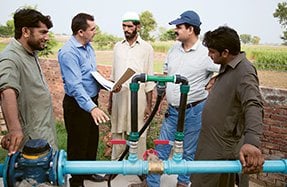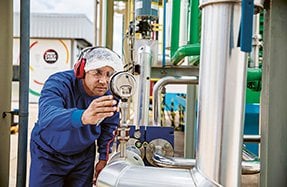Climate change leadership
Our commitment: Provide climate change leadership

Reaffirming our commitment to the Paris Agreement
We believe Nestlé is well placed to help address the climate change challenge. Our aim is to ensure the continuity of our own business and those in our supply chain while protecting the wider environment.
We are committed to further reducing GHG emissions along our value chain, in line with science-based targets. We also continue to strengthen our supply chain and help the farmers we work with become more resilient to climate change.
Progress against our objectives
| Our objectives | Our results |
|
Ongoing: As a member of RE100, aim to procure 100% of our electricity from renewable sources within the shortest practical timescale. By 2020: Reduce GHG emissions (Scope 1 and 2) per tonne of product in every product category to achieve an overall reduction of 35% in our manufacturing operations versus 2010. By 2020: Reduce GHG emissions by 10% in our distribution operations versus 2014. By 2020: Reduce GHG emissions by 10% in the 100 major warehouses we use versus 2014. By 2020: Expand the use of natural refrigerants, which do not harm the ozone layer and have a negligible impact on climate change, in our industrial refrigeration systems. By 2020: All new proprietary cold beverage dispensers of Nestlé Professional will use natural refrigerants. |
25.7% of the electricity we use comes from renewable sources. Reduced GHG emissions (Scope 1 and 2) in our manufacturing operations by 26.5% per tonne of product since 2010. Reduced GHG emissions in our distribution operations by 4.3% since 2014. Reduced GHG emissions in our major warehouses by 28.3% since 2014. 58 new refrigeration systems using natural refrigerants installed in 2017. R&D project is ongoing for the Nestlé Professional proprietary dispensing equipment, CoolPro, to determine technical requirements to switch to natural refrigerants. |
Manufacturing
We believe we are well placed to help address the climate change challenge through our manufacturing operations. Underpinned by The Nestlé Policy on Environmental Sustainability (pdf, 1Mb), our main focus is to reduce our greenhouse gas (GHG) emissions, by investing in renewable electricity, improving energy efficiency and switching to cleaner fuels. We are pursuing our science-based 2020 objective of reducing GHG emissions per tonne of product by 35% in our manufacturing operations since 2010.
Our objectives contribute to our efforts to limit climate warming to less than 2°C. Over the last 10 years, we have made real progress, reducing direct GHG emissions per tonne of product by 36.8% while increasing production by 35.3%. We remain on track to achieve our objective, as we have achieved an overall reduction of 26.5% in our manufacturing operations versus 2010.
Direct GHG emissions (million tonnes of CO2eq)
| 2017 | 3.5 |
| 2016 | 3.6 |
| 2015 | 3.7 |
Direct GHG emissions (kg of CO2eq per tonne of product)
| 2017 | 64 |
| 2016 | 65 |
| 2015 | 69 |
Indirect GHG emissions (million tonnes of CO2eq)
| 2017 | 3.0 |
| 2016 | 3.5 |
| 2015 | 3.7 |
Indirect GHG emissions (kg of CO2eq per tonne of product)
| 2017 | 54 |
| 2016 | 62 |
| 2015 | 68 |
Environmental Target Setting (ETS) programme
Our ETS programme is designed to help our factory teams improve water and energy efficiency, and reduce GHG emissions. For example, in March 2017, the Yinlu Hubei factory – our biggest water user and third-highest consumer of energy in the Greater China Region – sought to explore energy – and water-saving opportunities. We identified possible annual energy savings of 168 000 GJ, 745 000 m3 of water withdrawal reductions and a fall of 19 000 tonnes of CO2 emissions through the recovery and reuse of water and heat. The 45 projects built into the action plan are expected to save the factory CHF 2.3 million.
To further improve our environmental performance, we have developed a web-based tool, Do It Yourself. This enables each of our sites to identify and adopt energy- and water-saving opportunities that have already been successful elsewhere in the Group or are best-in-class solutions proposed by in-house experts. In 2017, 102 sites used the tool.
Increasing our use of renewable energy
We are increasing our use of renewable fuels, with 22 factories using spent coffee grounds as a renewable fuel and 27 factories using wood chips.
We aim to procure 100% of our electricity from renewable sources within the shortest practical timescale. All our operations have received guidance to help them optimise electricity consumption, better understand their local power market and identify opportunities for purchasing renewable energy from the local grid. Since 2016, when the guidance was published, we have doubled the share of renewable electricity we purchase to 25.7% (6.8 petajoules).
What has mostly helped to increase the share of renewable energy by 96% is the increase in renewable electricity (described below).
Transport and distribution
We transport more than 148 540 tonnes from 1667 warehouses daily – that’s the equivalent of driving 242 times around the world each day. Our transport and distribution operations generated 3.18 million tonnes of GHGs in 2016.
Transport
Our partnerships with third-party logistics providers enable us to track our environmental performance and improve efficiency by reducing distances, fuel consumption, GHG emissions, noise and congestion. Our reporting covers 72% of our total product volume.
We are making good progress towards our objective, with emissions per tonne of product down by 4.3% in 2016 compared with our 2014 baseline. We have achieved this by:
- Streamlining our distribution networks, route planning and vehicle space usage;
- Identifying and defining new transportation methods and alternative fuels; and
- Training our drivers to improve safety and environmental efficiency.
We strive to ensure that ‘no vehicle leaves empty’, avoid unnecessary journeys where we can and redesign distribution networks to improve efficiency. We also switch our transportation from road to rail or sea wherever possible (road transport is now down to 70% of total transport) and use natural gas in our trucks where appropriate.
Optimising vehicle utilisation
To prioritise logistics efficiency and improved sustainability, our Cereal Partners Worldwide business is applying three simple principles: choosing the right-sized vehicle, making sure the vehicle is full on every journey and fully utilising each vehicle’s capacity. This comprehensive approach has been adopted by several markets, leading to 1600 fewer trucks on the road and a reduction in CO2 emissions of 825 tonnes in 2016.
Emissions from transport (estimated million tonnes of CO2eq)
| 2016 | 3.2 |
| 2015 | 3.2 |
| 2014 | 3.2 |
Transport modes – global
Cumulative GHG reductions from 2011–2016 based on changes to transport modes compared to 2011 (tonnes of CO2eq saved)
| 2016 | 331 000 |
| 2015 | 250 000 |
| 2014 | 225 000 |
Cumulative GHG savings from 2011–2016 (per tonne of product dispatched) based on changes to transport modes compared to 2011 (%)
| 2016 | 9% |
| 2015 | 7% |
| 2014 | 7% |
Warehousing
We also search for ways to reduce the energy consumption in our warehouses, by improving illumination, heating, cooling and insulation. We are particularly focused on switching to renewable energy. We are currently on track to meet our 2020 objective, having reduced emissions in our top 100 warehouses to 6.5 kg CO2eq per tonne of product, a fall of 28.3% against our 2014 baseline.
Emissions dispatched through top 100 warehousing (kg CO2eq per tonne)
| 2017 | 6.5 |
| 2016 | 8.0 |
| 2015 | 8.7 |



